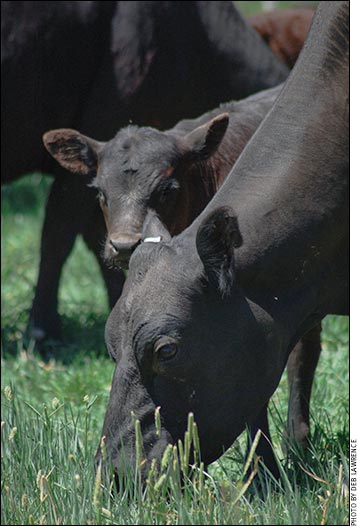Keeping Cattle Healthy Without Antibiotics
Keeping cattle healthy can be a challenge. It became easier with the advent of vaccines and antibiotics. For many decades cattle producers routinely addressed disease by using vaccination for prevention and antimicrobial drugs for treatment. The use of pathogen-killing drugs is questioned today, however, due to increasing numbers of drug-resistant pathogens. Microbial resistance diminishes effectiveness of some of the drugs on which we’ve come to rely.

There are also drug residues if drugs are not used appropriately and if withdrawal times are not observed. Consumers are concerned about the safety of meat products. Many beef producers and veterinarians are looking at alternatives to antimicrobial use. Key factors in this goal include reducing exposure to disease while at the same time keeping immunity strong.
Andy Allen, Washington State University (WSU), says the biggest thing a producer can do to minimize use of antibiotics is make sure cattle have good nutrition.
“This enables the immune system to fight off infections. Diet must include adequate protein, energy, vitamins and trace minerals — with copper, selenium and zinc being the main trace minerals needed for a healthy immune system. This may require testing feeds, and the producer may need a custom trace-mineral mix,” he says.
“Even if you are providing the required amount of copper, it may not be enough if there is too much molybdenum, sulfur, iron or zinc that might bind to it. We recommend working with a nutritionist to figure out proper levels of trace minerals for each ranch,” says Allen.
“Assessing body condition is crucial throughout the year, making sure cattle are somewhere near the ideal range of 5 or 6,” he says, referencing a 9-point BCS scale (see www.cowBCS.info for more information). “There is a big push today for cost-effective ways to feed cattle, but you need to balance this with body condition.” It might cost more in the long run if cattle become thin, causing a higher incidence of disease and the need for more antibiotics.
Allen works with the Field Disease Investigation Unit at WSU.
“We investigate disease outbreaks,” he explains. “The second-most-common thing we see associated with increased disease incidence (and more use of antibiotics) is high stocking density — too many animals in a small area for too long.”
This is particularly important before and during calving. Management of cows precalving is crucial for preventing sickness in baby calves. Keep the environment clean. Don’t calve in the same area where you fed cows through winter.
“If you leave cattle in the same place too long, pathogens build up. There will be higher numbers of bacteria, viruses and protozoa that cause calfhood diseases,” he points out. Calves are more vulnerable than cows because they don’t have an experienced immune system yet. A good vaccination program for cows and making sure every calf gets adequate colostrum are also important in preventing disease in young calves.
Equally important is reducing stress, since stress hinders immune function.
“Weaning is a big stress, so preconditioning programs may be helpful, setting up a program that’s appropriate for your ranch and working with your veterinarian. If you plan to vaccinate ahead of weaning it should be done several weeks ahead,” says Allen.
Make sure working facilities flow well. The less time cattle must be confined, and the quieter they are moved and handled, the less stressed they will be.
“During stress their cortisol levels rise, and when that happens their immune system drops. Practice with a group of calves, putting them quietly through the facility without being worked; then they are not as upset and stressed when you put them through again,” says Allen.
“Many producers give antibiotics to cattle that don’t need them. If it’s a condition that antibiotics won’t help (such as viral diseases, or retained placenta without systemic infection), we’re just increasing the chances for development of resistant bacteria,” says Allen.

Editor’s Note: Heather Smith Thomas is a freelancer and cattlewoman from Salmon, Idaho.





